Why you can trust Tom's Hardware
Our HDR benchmarking uses Portrait Displays’ Calman software. To learn about our HDR testing, see our breakdown of how we test PC monitors.
The AW2523HF includes HDR support, as do all the 360 Hz screens here. Without a wide gamut, though, the effect is more subtle. Honestly, HDR isn’t the reason to buy a fast gaming monitor, but as you’ll soon see, the AW2523HF is missing something that the others have.
HDR Brightness and Contrast
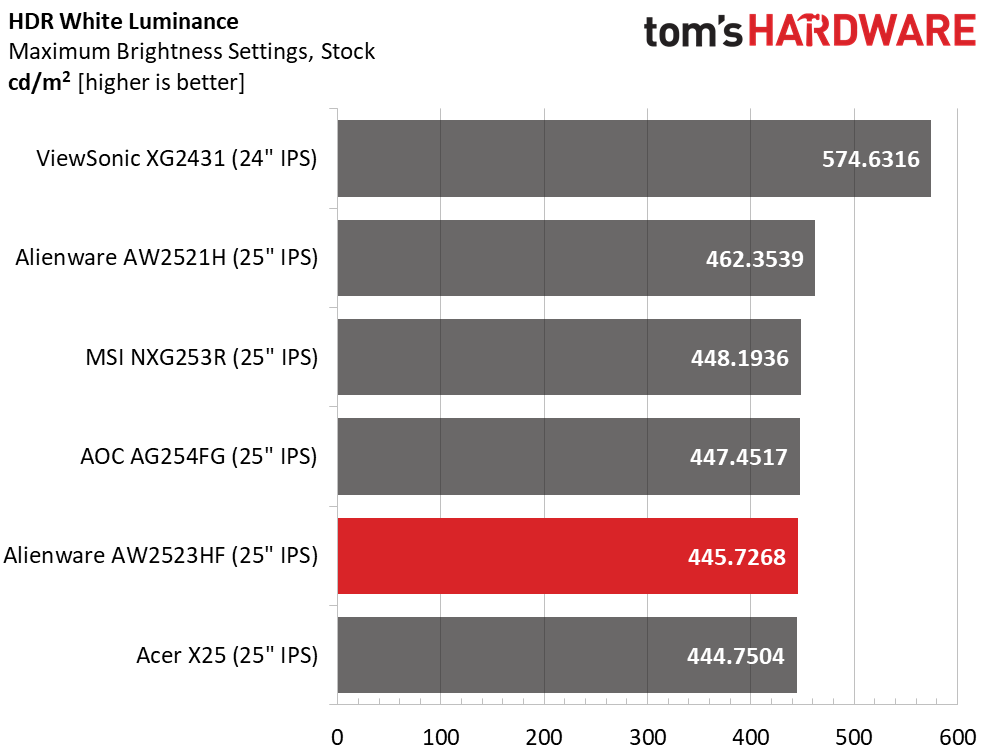

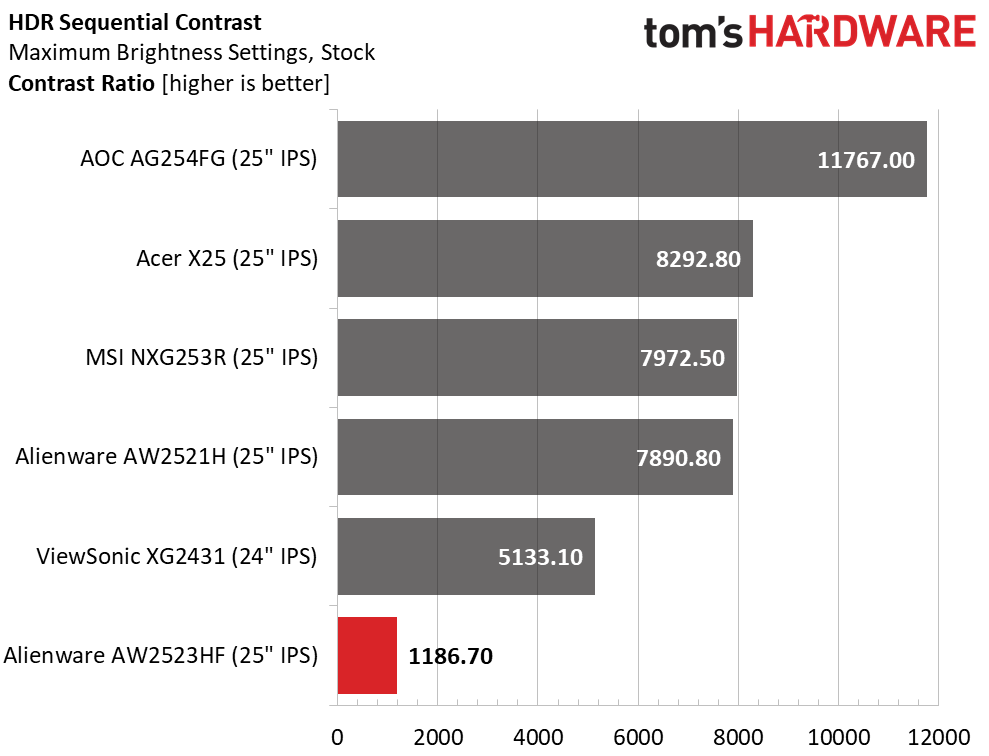
The first chart shows nothing special. All the 360 Hz screens have roughly the same peak brightness, with the ViewSonic delivering about 112 more nits. But the black level chart shows something that raises an eyebrow. Indeed, the AW2523HF is the only one with no dynamic contrast.
There’s no field or zone dimming feature, which means that SDR and HDR contrast are the same. This defeats the purpose of HDR support. But since one would buy this monitor for its performance, the solution is simple. Don’t play games in HDR. You’ll save some processing load which will deliver higher frame rates. And I’d probably extend that advice to all these screens. 360 Hz is about speed. The panels offer enough contrast to make games look amazing.
Grayscale, EOTF and Color
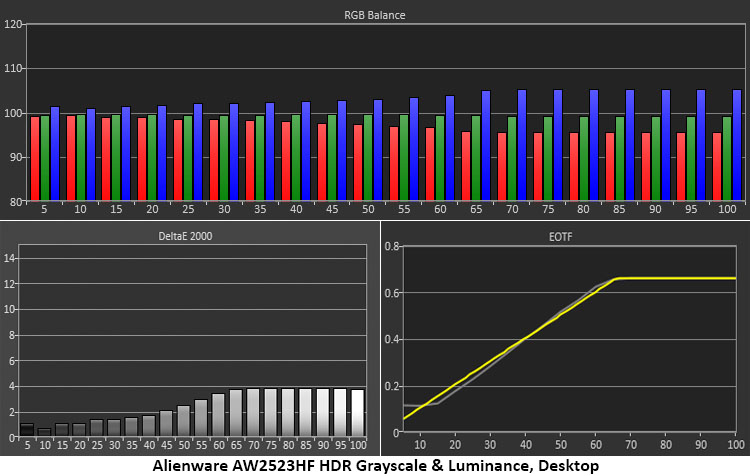
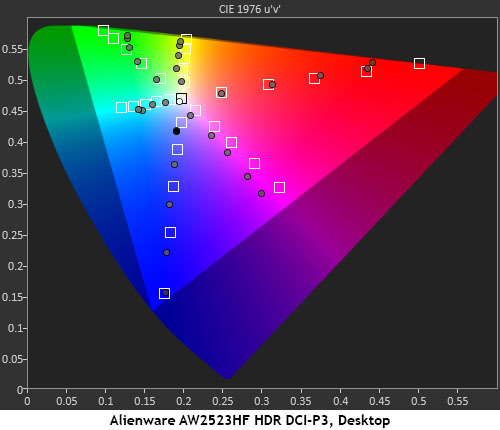
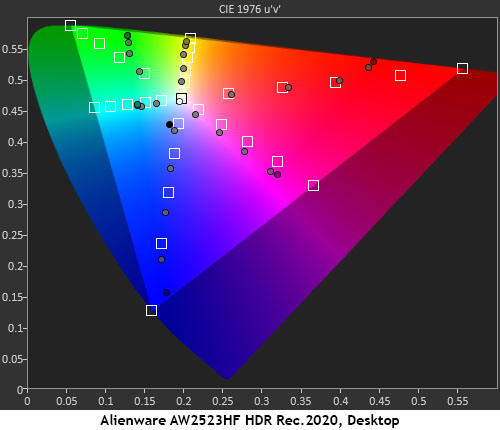
I tested all three HDR modes and found that color-wise, they were nearly identical. I recommend Desktop because it is the only one without edge enhancement. Game and Movie attempt to sharpen the image, but the net result is less motion resolution, which is not the reason one buys a 360 Hz monitor. Grayscale tracking is slightly blue, but the errors aren’t visible in content. The EOTF starts too light, so shadow areas are gray rather than black. The line then tracks the reference up to a 65% tone-map transition, also to spec.
Though the AW2523HF is an sRGB monitor, it does a respectable job with wide-gamut content. For material mastered in DCI-P3, it follows the saturation targets until the display runs out of color at around 80% for red and green. Blue is slightly over-saturated. It shows the same behavior with Rec.2020 content running out of red at around 70% and green at 60%. So, it’s making its best effort to show you the more saturated color, which is as it should be.
MORE: Best Gaming Monitors
Get Tom's Hardware's best news and in-depth reviews, straight to your inbox.
MORE: How We Test PC Monitors
MORE: How to Buy a PC Monitor: A 2022 Guide
MORE: How to Choose the Best HDR Monitor

Christian Eberle is a Contributing Editor for Tom's Hardware US. He's a veteran reviewer of A/V equipment, specializing in monitors. Christian began his obsession with tech when he built his first PC in 1991, a 286 running DOS 3.0 at a blazing 12MHz. In 2006, he undertook training from the Imaging Science Foundation in video calibration and testing and thus started a passion for precise imaging that persists to this day. He is also a professional musician with a degree from the New England Conservatory as a classical bassoonist which he used to good effect as a performer with the West Point Army Band from 1987 to 2013. He enjoys watching movies and listening to high-end audio in his custom-built home theater and can be seen riding trails near his home on a race-ready ICE VTX recumbent trike. Christian enjoys the endless summer in Florida where he lives with his wife and Chihuahua and plays with orchestras around the state.
-
Sleepy_Hollowed Wow, this is a great monitor, on my shortlist now, thank you for the review.Reply
I love that it has no speakers (this is a plus for security AND in case they start buzzing later on due to crappy parts), and while the resolution is even more exotic than the 1920 x 1200, the extra pixels are great for doing work when not gaming.
Alienware/Dell keep knocking it out of the park in the monitor department it seems. -
patrickisfrench the 1920x1440p is a typo. tech specs from dell show standard 1080 HD resolution for this one.Reply -
Sleepy_Hollowed Reply
Thank you.patrickisfrench said:the 1920x1440p is a typo. tech specs from dell show standard 1080 HD resolution for this one.
That's both a plus and minus then, it's better for gaming for sure, not so much for work, but it is what it is. -
escksu Wow 360Hz. Thats 2.77ms per frame!!Reply
IMHO, its a bit overkill for online gaming as even the best internet gaming servers has around 20ms latency. However, it still cool. -
brandonjclark Reply
What formula are you using when calculating that, sir?escksu said:Wow 360Hz. Thats 2.77ms per frame!!
IMHO, its a bit overkill for online gaming as even the best internet gaming servers has around 20ms latency. However, it still cool. -
GEO_SD I just recently bought this monitor. The alien vision cross hair is a really useful feature imo, it can be configured in the command center. There's only one worth using and it's the crosshair small, it's available in 5 different color variations. Crosshair small is the perfect size, very useful as it uses two colors for the small Crosshair(I use black with white inner crosshair) . There's also a dot you can use but I find it too small. The toggle on and off for it is also super simple, just using a directional input from the joystick. I'll attach a picture soon to reference what I mean about the dot and crosshair small. All the other alien vision settings don't have a practical use. I'll update this comment for a long term use of the monitor.Reply